When growing an ecommerce business, most companies focus their marketing efforts on new customer acquisition.
But the problem with acquiring new customers is that it’s expensive. And in reality, maintaining a strong relationship with your existing customer base is far more effective for scaling your business.
Retaining your existing customer base should be an equal or higher priority when growing your ecommerce store. It’s also much cheaper.
But don’t take my word for it.
Marketing Metrics reports the probability of selling to an existing customer is 60-70%, whereas the probability of selling to a new prospect is 5-20%.[*]
After all, your existing customers already know and trust your brand and are more likely to buy from you again.
Focusing more time and money marketing to your existing customers and boosting your customer lifetime value (LTV) can have a significant impact on your revenue.
In this post, I will show you how to leverage the power of repeat business and increase your customer lifetime value.
%(tableofcontents)
In addition, I’ll reference data from my own ecommerce store and my experiences selling on Amazon to provide you with real-life examples you can emulate.
Customer Lifetime Value With Real Stats From My Store
The best way to illustrate why customer LTV is vital for your ecommerce success is to reference some actual data.
I own Bumblebee Linens, a seven-figure ecommerce store that sells handkerchiefs and linens targeted to the wedding industry.
Because most people don’t get divorced and remarried over and over, I used to think all my customers were one and done. But I was completely wrong.
When I ran the numbers for my business, I discovered that repeat customers make up a significant percentage of my overall revenue!
In fact, repeat business is one of the primary reasons for my small-business success.

As you can see in the chart above, while only a small fraction (just 12%) of our customers are repeat customers, they make up over 36% of our total annual revenue.
This means 30%-40% of my annual sales are already in the bank at the end of the year without me doing any work.
When I saw this data, I started dedicating additional resources to selling more to existing customers instead of focusing solely on new customer acquisition. As a result, the B2B side of our business has been the largest source of growth for our store.
After all, repeat business not only provides peace of mind, but it also allows my revenue to be more predictable.
The 80/20 Rule Of Repeat Sales
For Bumblebee Lines, roughly one-third of our annual revenue comes from business-to-business (B2B) such as hotels, small airlines, and event planners. These “regulars” provide a strong foundation for our business and keep it up and running.
Every business has some component of B2B sales, no matter how unusual the product. For example, Neville Medhora used to sell rave equipment over at HouseOfRave.com and discovered that plumbers were buying his fingerless lights in bulk!
As a result, when you plan out your marketing budget, a significant portion of your money and time should be spent analyzing the buying patterns of your existing customer base and going after repeat business.
However, you can’t chase everyone. This is especially true if you are a small business owner with limited resources. You must be selective!
To increase your repeat sales, you should focus your efforts on a specific pool of customers who are guaranteed to boost your profits.
But who are these customers, and how do you find them? This is where the 80/20 rule comes in.
Below is an analysis I recently performed on Bumblebee Linens.
First, I created a special segment in Google Analytics based on customer revenue.

Then, I used this data to create a breakdown of my customer distribution based on average order value (AOV) – or the average total of a customer’s order.
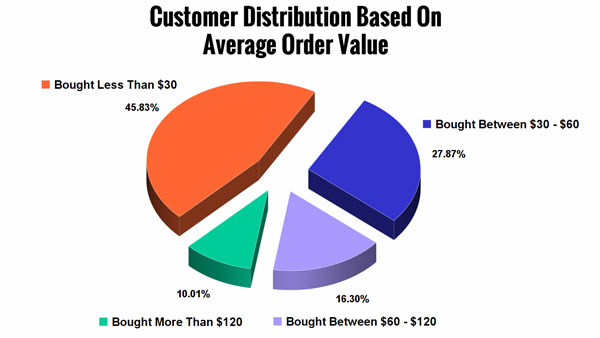
Note: The average order value for Bumblebee Linens is around $60, which is why I chose $30 (half of my AOV) and $120 (double my AOV) as my thresholds. You can create these reports on your own by creating segments in Google Analytics. Or, you can simply download this data directly from your shopping cart and use a spreadsheet to collate your numbers.
According to the graph above, almost half of my customers (about 46%) spent less than $30, and only 10% spent more than $120.
In other words, most of my customers spend less than half of my AOV!
Then, I took a look at my revenue distribution as a percentage of sales based on AOV.
I was astonished to find that my big spenders – customers who spend over $120 per order – generate almost half of my overall sales.
But my cheapest customers – those who spend less than $30 per order – contribute only 12.6% to the bottom line.

While I don’t have many big spenders in my customer pool, they are the customers that generate the most revenue for my business.
To break this down:
- My top 10% of customers yield 51% of our revenues
- My top 20% of customers yield 67% of our revenues
In other words, my top 20% of customers are generating the bulk (67%) of our sales, and that’s where my focus should be.
This is also known as the 80/20 (67% is close enough) rule of business:) Find your top 20% of customers and give them special treatment!
How To Increase Your Customer LTV Step By Step
Now that you recognize the importance of LTV for your business, we’re ready to discuss how to go about increasing it.
Below is a step-by-step guide you should bookmark and follow.
Step 1: Increase Your Average Order Value
By increasing your AOV, you increase your customer LTV. So your first step is to increase the money a customer spends in any given transaction.
With a higher AOV, you can also afford to spend more on ads, make a higher profit per sale, and generate more revenue for the same amount of work.
Here are some ways you can increase your average order value.
Increase Your Free Shipping Threshold
The quickest and simplest way to increase your AOV is to raise your free shipping threshold by 15–20% or by the cost of an additional item in your shop.
For example, if your average order size is $50, then set your free shipping threshold at $60. This should encourage customers to add more items to their shopping cart to qualify for free shipping.
Warning: Increasing or lowering your free shipping threshold may or may not have an effect, depending on consumer behavior.
I recommend you experiment with a free shipping threshold first. Begin by setting it anywhere from 15–20% above your current AOV and adjust accordingly based on your profit numbers.
Offer an Upsell Before Checkout
A customer is much more likely to spend more money after they take an action on your ecommerce store. You want to encourage visitors to increase their order just after adding an item to their shopping cart.
This strategy works well because the customer has already demonstrated an intent to buy.
For example, if Noah Kagan inserts a taco in his shopping cart, I sure as hell am going to upsell him with hot sauce.
In general, upsells don’t always have to be initiated after an add to cart. It doesn’t matter what action a customer takes, as long as they take some action on your site.
For example, if a visitor signs up for your newsletter, you should thank them with a special offer.
If you sell on Amazon, you can also add upsells to your product listings to boost your AOV.
Under the advertising tab in Seller Central, create a percentage off promotion as shown below. Set up your discount so a customer gets a significant quantity discount when additional items are added to the cart.
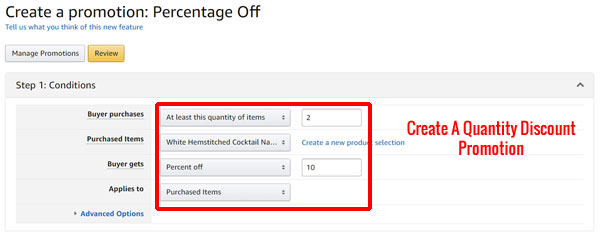
From my experience, you’ll likely see an up to a double-digit increase in average order size overnight.
Offer an Upsell After Checkout
Offering a special promotion to your customer after checkout is also one of the best times to make an additional profit.
In fact, you can increase your AOV by up to 10-30% by simply providing product recommendations. After a purchase, customers are hot and excited which means you can easily get them to throw in a few extra items.[*]
Boom By Cindy Joseph increased its revenue by 11% using this exact tactic.
Here’s what the upsell looks like in the example below.

Bundle Your Products Instead Of Selling Them Individually
Another great way to make more profit is to bundle your products together in multipacks. We use this strategy frequently for Bumblebee Linens, and it works.
For example, the average cost of a single handkerchief in our store is $6. If a customer buys only one hankie, it’s not really worth selling. Plus, the low AOV makes getting a positive advertising ROI problematic.
Instead, we require customers to buy at least three handkerchiefs at a time by packaging them into three packs.
We also offer special sets of 6 and 12 handkerchiefs at a discount to boost our AOV. This significantly increases our profit by as much as 2-8X per item.
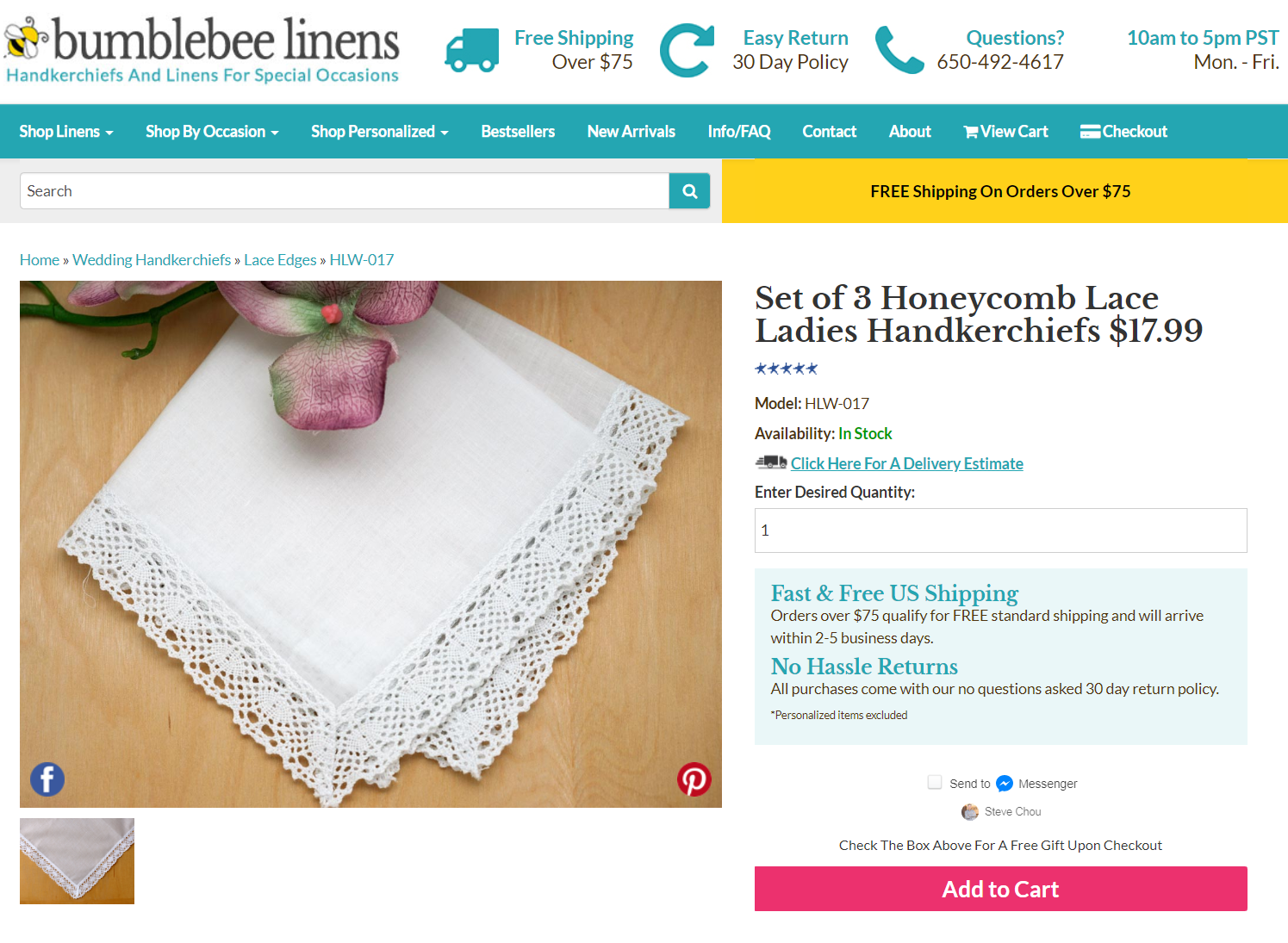
Even if most of your customers only want a single unit of your product, you should offer them a bundle at a discount. They will likely take you up on it.
Overall, when growing your ecommerce store, increasing your average order value has many benefits.
Not only will your advertising be far more effective, but you will also have more budget to work with to improve your overall customer experience and customer LTV.
Step 2: Isolate Your High AOV Customers And Sell More To Them
With the right tools, you can easily find your best customers. Most ecommerce platforms allow you to export your customers and purchases into a CSV file that you can separate into lists. We recommend segmenting your largest business customers first.
For example, when we create lists for Bumblebee Linens, we look for customers who have purchased an unusually high volume of linens.
Most normal people only buy a dozen or so napkins at once. So if someone buys three or more dozen linens in a single order, there is a high likelihood that they are a business.
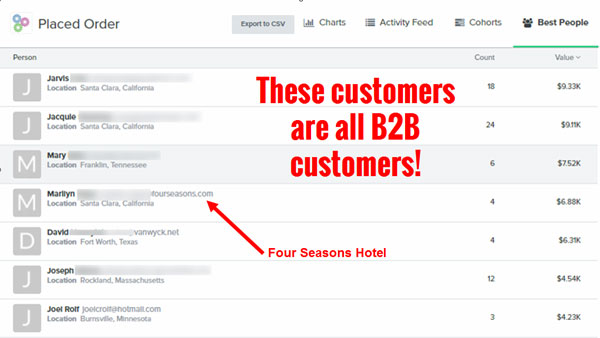
Specifically, I look for the following…
- Customers who have purchased over twice my typical average order value
- Customers who have purchased more than once
- Customers who have purchased the most over all time
Once you’ve located these customers, you can run specially targeted promotions, advertisements, and emails to encourage them to buy more products based on what they’ve purchased in the past.
By focusing your ad dollars on repeat purchasers and large business customers, you can achieve an insane return on investment (ROI) for your ads.
After all, your best customers have buying power, they are not price sensitive, and they will buy frequently.
For my store over at Bumblebee Lines, most people who buy large quantities of linens are event or wedding planners who consistently buy in bulk from us.
Step 3: Find Your Whales And Treat Them Like Royalty
While you are making a list of your best customers, you also want to pay special attention to your top spenders.
After all, your top spenders (otherwise known as your whales) will serve as the foundation for your business. Once you’ve identified your whales, you should reach out and establish a personal connection.
Here’s exactly what I do.
First off, I always call my customer and speak with them directly. From my experience, a phone conversation works best. You can always email your customer, but I prefer voice because it establishes a stronger connection.
Once I get them on the phone, I provide them with a range of perks, including a dedicated representative and special discounts.
Here’s what I say pretty much verbatim.
Hi, my name is Steve and I’m the founder of Bumblebee Linens. I noticed that you are an event planner and you regularly buy our products.
We would like to offer you a discount on all future orders and a dedicated representative who will keep track of all of your shipments. For your future events, we will make sure that your linens arrive on time and we’ll pay special attention to all of your orders.
Whenever I speak to my large customers, I always treat them like a friend; I’ll often engage in small talk, depending on their personality.
Relationships matter! Once you’ve had a few phone conversations, you’re well on your way to creating a lifelong customer.
Please do not confuse this with cold calling. Your whales already know your business and love your products. In fact, most customers I contact directly are happy to talk to me!
Getting your customers on the phone is also a great opportunity to remind them about your loyalty and referral programs as well!
In the end, building a strong relationship with your customer is a win-win for both parties. They get special treatment and you get repeat business.
While one on one phone conversations aren’t scalable, they are very effective. After all, even a single repeat whale can drastically affect your bottom line. The effort is worth it. So don’t be afraid to pick up the phone!
Step 4: Find New High LTV Markets
Never underestimate the power of Facebook for finding new high LTV markets to pursue.
To find buyers who have high purchasing power for your business, you should create the following “lookalike audiences” on Facebook.
- Repeat purchasers
- High LTV customers
By uploading your customer emails, you can have Facebook automatically discover new customers who match your profile.
Here’s what a few of my lookalike audiences look like from my Facebook ads account.
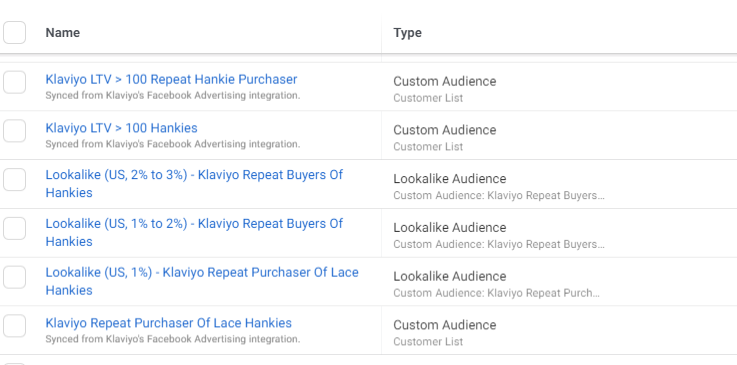
Once you create your lookalike audiences, you can leverage Facebook ads to dramatically scale your business. This is how most ecommerce businesses can grow exponentially.
Step 5: Offer Special Perks For Existing Customers
One proven way to keep your customers coming back and generating loyalty for your brand is by offering special perks. Here are some strategies I use with my store.
Implement a Referral Program
A simple way to keep a customer coming back is to reward them for recommending your business to a friend through a referral program.
By providing a coupon or a gift card as a thank you for both the referrer and the referred, you will increase your sales even further.
Offer Discounts
The key to offering discounts is to not over-discount. And it is important to make sure that these offers only go to customers who wouldn’t normally purchase from you otherwise.
As a result, you must structure your discounts based on consumer behavior.
For example, I might give a 10% discount to a customer who hasn’t purchased in two months but a 20% discount for a customer who hasn’t purchased in three months.
If a customer is a regular, they may not even need a discount to buy again. Sometimes, a reminder is good enough.
This discounting strategy is called a discount ladder because you only discount the minimum amount necessary to yield an additional sale.
If you can't implement a discount ladder, you can always email a coupon to your entire customer list but this strategy isn’t as efficient.
Invest In a Loyalty Program
Another tried-and-true method of increasing LTV is to invest in a good customer loyalty program.
Here are some benefits of running a loyalty program:
-
Customers value loyalty points: A good loyalty program will create an emotional connection between your customer and your brand. Also, giving away free rewards points is much cheaper than giving away discounts, but they are equally as appreciated.
-
Customers will be committed to your store: When a customer signs up for your loyalty program, they instantly become a potential high LTV customer. This opens the lines of communication further because you know they want to hear from you.
-
Customers are more likely to generate referrals: A good rewards program should encourage customers to refer their friends and family. You can give away free rewards points when a customer refers a friend.
Try Direct Mail Marketing
Similar to coupons and discounts, direct mail marketing is a great way to deliver a key message to your customer. Most direct mail services allow you to instantly import your customer list from your email provider and send out thousands of postcards, catalogs, or pamphlets automatically.
There are many benefits of direct mail marketing for your business. These include:
- An increase in brand awareness of up to 70% more than digital marketing.[*]
- A 28% increase in spending on your website.[*]
- 57% claim that receiving mail makes them feel more valued.[*]
- An immediate 79% action rate as opposed to 45% for email marketing.[*]
Recently, I launched a postcard marketing campaign and achieved a 16.47X return on ad spend. Snail mail works!

Step 6: Cross-Sell To Your Existing Customers
Remember the handy spreadsheet you created in step 1? You’ll need it again. This time, go through it and sort your customers based on what products they bought.
Then, come up a “related items” list that they might be interested in and pitch these products to them in a friendly email.
For example, our research shows that a customer who purchases dinner napkins from Bumblebee Linens is likely to buy cocktail and tea napkins.
In addition, a customer who buys a handkerchief for a wedding has an extremely high likelihood of buying a handkerchief gift box.
Using this information, we always cross-sell related products to customers who match this buying profile in our email post-purchase sequence.
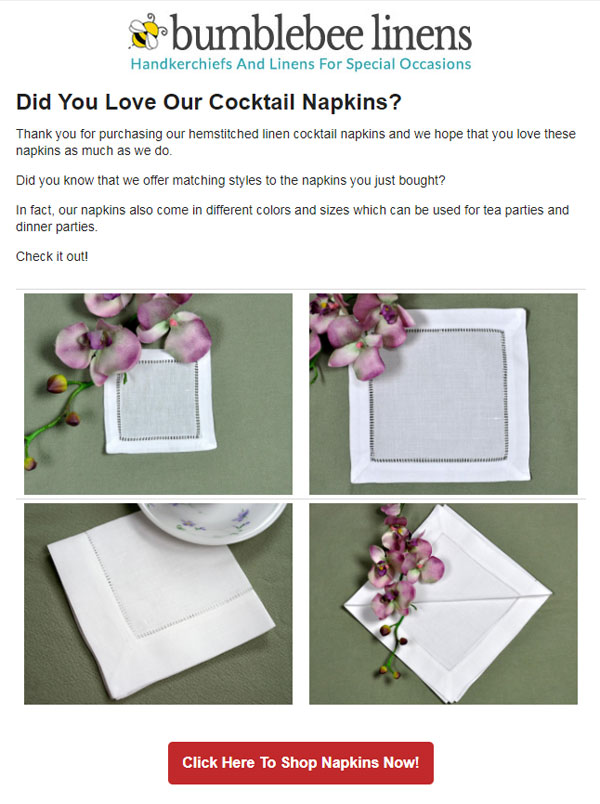
Step 7: Send More Email
In addition to building relationships with your top customers by phone, you can also boost your repeat customer rate by sending out direct email campaigns to your existing customer list.
Most online store owners are afraid to send emails because they don’t want to annoy their customers.
But customers are more resilient than you think! After teaching my ecommerce course for over a decade, I found that most businesses don’t send enough emails. In reality, email marketing should make up at least 20% of your revenue.
For example, on average, 30% of Bumblebee Linens’ revenue comes from email marketing and this month it’s coming in at around 27%.

About 8% of this revenue is the result of our automated email campaigns and here are some examples of what you must implement:
-
Abandoned cart: These emails are sent when a customer begins to check out but doesn’t finish the process.
-
Pre-purchase sequence: These emails humanize your brand and convince customers to make their first purchase.
-
Post-purchase sequence: Following a purchase, this sequence can be used to generate reviews or cross-sell related products.
-
Win back: Customers who have purchased once but have not purchased again in a while can be enticed to come back with coupons and special offers.
-
View through abandoned cart: Customers who viewed a product but didn’t check out are sent reminder emails and suggested products.
While your automated email campaigns make money on auto-pilot, the real money lies with your direct campaigns.
Direct campaigns make up 22% of my email revenue; this is where most people don’t send enough emails.
Whenever Bumblebee Linens runs a promotion, we send out up to six emails over a span of a week. Here’s a typical send sequence.
- Email #1: Sale announcement and deadline
- Email #2: Resend email #1 to non-opens
- Email #3: Sale ends soon – deadline coming up
- Email #4: Resend email #3 to non-opens
- Email #5: Sale ends today – take advantage of it
- Email #6: Sale extended to an additional day
While this email sequence seems excessive, note that over the holidays in 2019, we emailed our entire customer list every day for 12 days straight and every single email converted to a profit.
And here’s the thing. Very few people complained and our spam rate was 0%!
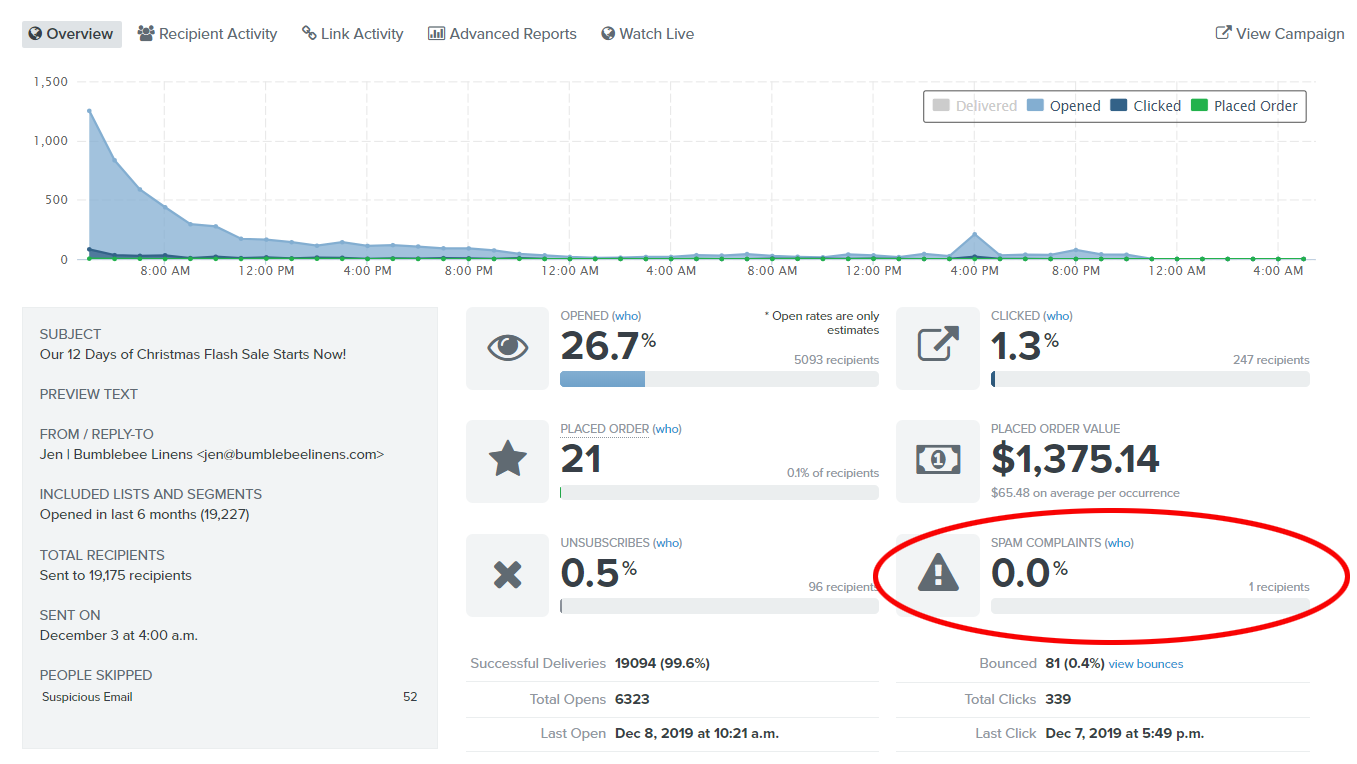
The take-home message is: Get out of your comfort zone and experiment with increasing the frequency of emailing your customers.
If you are emailing every other week, try every week. I guarantee you that your customers won’t mind and you will make a healthy profit.
Putting it all together
Growing your repeat business is crucial for the long-term survival of your ecommerce store. While most business owners focus on new customer acquisition, your relationship with your existing customers is actually the secret to scaling your revenue.
While I mentioned a bunch of concepts in this post, here are some action items for you in order of priority:
- Make a list of your whales and call them on the phone.
- Cross-sell products to your best customers via email.
- Increase your AOV by adjusting your free shipping threshold and bunding.
- Send more emails.
- Offer special perks and referral programs.
Remember, you don’t have to do all of these things. Just pick one and do it well! Good luck.










Add A Comment
VIEW THE COMMENTS